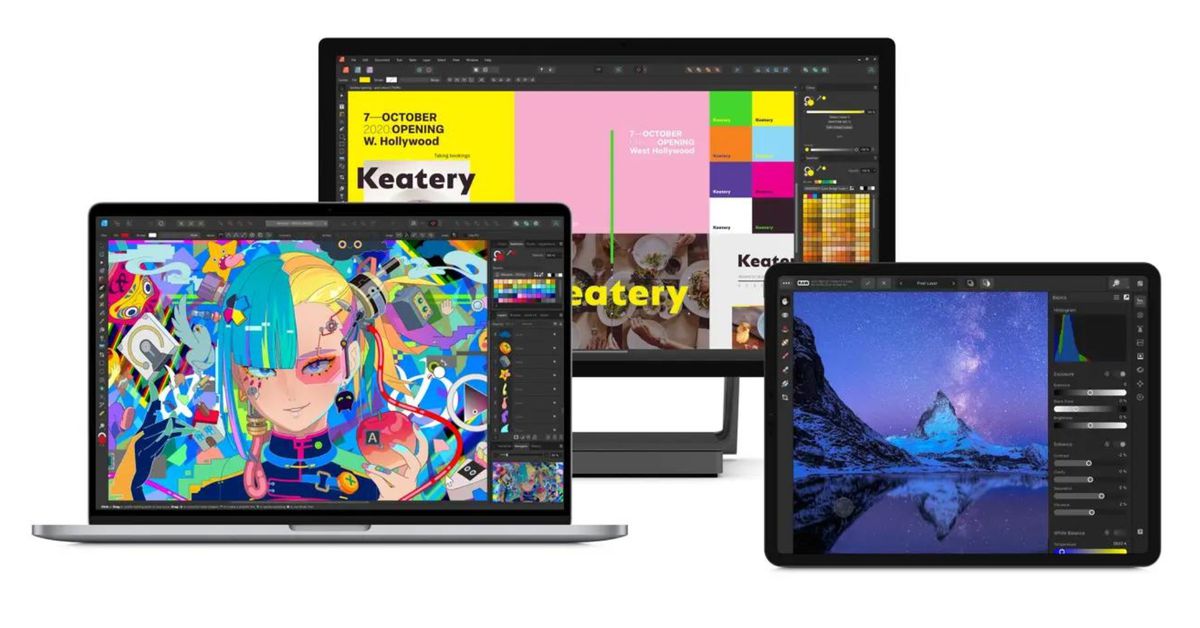I dumped my Adobe sub and grabbed Affinity Photo a while ago. It does 95% of the things Photoshop does (and 100% of what I need) for a one-time payment that is a fraction of the cost of an Adobe payment. It’s runs so so SO much better than PS. I very often saw Photoshop using up to 40gb of RAM and Affinity Photo uses 9gb doing the exact same work with the same files.
Removing Creative Cloud and it’s 838 different processes was amazing. Like finally watching your toilet flush after it’s been clogged.
The Canva ownership still worries me.
For a software that has a perpetual license, I’m not too worried.
Yeah, uh, Adobe products had that too - emphasis on the “had”. Lots of complaints from customers that their licenses are just randomly getting deactivated, that they need to buy a new version, that they were supportive piracy…
I own Affinity Photo 1+2 but I will hop ship to yarr town the second they pull bullshit like this. Trust no one, you just get burned.
Back before software subscriptions were a thing, I had a few different licenses which I would have assumed were perpetual.
In a way they were, but then my version stopped receiving updates and version 2 came out and they wanted me to buy version 2.
So perpetual licenses don’t mean anything if the company wants to be a jerk about it.
In a way they were, but then my version stopped receiving updates and version 2 came out and they wanted me to buy version 2.
That’s… how it works? Surely you can’t expect ongoing, infinite development without paying an ongoing cost. Eventually the current version will become the old version, and stop receiving updates.
I’ve seen this take before, and it’s always been bad.
Back when perpetual licenses were normal - yeah, you could always install that software from the CD or whatever and input your key and activate it. As long as you were running it on a supported OS, it worked. Most of the time you’d get updates for a while, for the most popular software at least, but not always.
Then eventually, everyone who was going to buy it had bought it, mostly. The money stopped rolling in, and no one’s going to make updates for free. So updates stopped.
Over time, it would just become not as good. It didn’t change, the world around it did. New security vulnerabilities would be found, or the OS would update and it wouldn’t be compatible anymore. Sure you could run the old OS, and it would work how it always had. But then vulnerabilities in the old OS would show up, or the newer OS would have a feature you want, or not be compatible with newer software you also want to run. It wouldn’t be feasible to run that old software anymore.
That doesn’t mean that the company didn’t fulfill their promise. A perpetual license you bought, and a perpetual license you got. Office 2003 still runs on Windows XP. But neither of them are secure anymore, and besides, 2003 is missing a ton of features.
So they publish the next major version. It has new features (Office 2007 introduced docx, the ribbon, and SharePoint), and will get security updates while it’s supported. People buy it and use it for a while, then the same thing happens as Office 2003. It ages, and goes to the wayside. People start buying Office 2010.
Eventually, the world speeds up. The Internet becomes faster and more reliable. Updates can happen faster and more consistently. People begin to expect updates for longer. The companies decide the best way to respond is to shorten the cycle. Instead of paying a large sum every few years for the latest version, they’ll pay a small sum every month. Instead of major updates with new features every few years and only bug fixes or security patches in between, will trickle out new features as they finish along with security updates.
The thing is - the pricing hasn’t actually changed that much. The only difference is that the cycle is smaller, and some people are just now realizing that there has always been a cycle.
CNET posted an article in 2006 with Office 2007 pricing, putting the Home edition at $150. That’s $233 now. That’s about 3 years, 4 months of Office 365 Personal ($70/year).
3 years after Office 2007 came out, Office 2010 was released. Do you see what I’m getting at? The cost you paid for 2007, in terms of a modern subscription cost, is the same as the time between the two major versions back then.
Sure, you could run it until 2017 with security updates if you were frugal, but trust me it looks pretty goofy to run Office 2007 on Windows 10. And besides, most people didn’t. They bought their Windows Vista computer and bought Office 2007 with it at the Best Buy. When they bought their Windows 7 computer at that same Best Buy 3 years later, they bought Office 2010 to go with it.
So really, the license was perpetual, sure. But the software lifetime was never infinite, and people that act like they got cheated on their perpetual license because of that are foolish. The only thing that has changed is the length of the cycle. It went from paying every 3 years and getting major updates every 3 years to having money trickle out and features trickle in.
I know this is a controversial take here, but I don’t think that’s necessarily a bad thing. It just makes it more obvious how much you’re spending, because you’re paying more often, which some people don’t like.
Those are good points actually.
You’ve changed my opinion about how I felt about version 2.
I’m totally fine as long as I can install ans use the old version, rather lossing access the moment I stop paying. Goofy or not, I only cares if it works.
Yep, I’m still suspicious we’re in the good phase before things get anti-consumer
Absolutely - me,too.
But, to play the optimist for once - Canva could bring some good to Affinity/Serif. Canva is available as a native linux app and Serif in the past has stated multiple times it’s mainly the lack of Linux resources and experience that stops them from providing Linux support. So maybe that could be a good influence.
Canva also has a workflow that is based on a webapp that is more “beginner friendly” than Affinity and a good integration between these services could be a good thing as it may remove barriers.
And Canva for a long time had a desire to provide a full production workflow, so maybe affinity gets the long missing library features.
BUT: Now enough with that optimism, sadly I am rather sure enshitification is around the corner. Which will be a sad day for me.
The only blocker to me is it doesn’t have native Linux support
Important point, and they also said they didn’t plan on supporting Linux.
They’re changing things up after being bought up, but I’m not sure if Linux is a priority for them yet
Had a lengthy mail exchange on that topix with them - before them being bought, though.
While they don’t plan a native Linux version they absolutely were open to optimise towards better Wine usability - which I totally could live with for now.
But I have no idea how the buying by Canva influenced things - Canva does have a linux app so maybe there are more resources and a different focus now.
This means it runs with WINE? Or something similar?
WineDB says all their apps are “Garbage” status - eg does not run.
So no Linux then, unless running a virtualized Windows.
I tried it with bottles. It installed fine after manually installing dotnet 4.8, but I couldn’t get Affinity Photo itself to run, even after extensive tweaks. All I get is an exception without any description in the terminal output.
Are they actually .Net Framework apps or they just use it for some parts? If they are, they could transition to .Net which is cross platform. With some work, of course.
The Affinity Suite started out as macOS-only apps which later got ported to Windows so I would be very surprised to hear they had any substantial portion written in .net
Yeah, I even wonder why they need it at all.
If they had library management even close to what lightroom offers, I’d be there.
I may yet jump ship for photoshop.
I think it’s only a good thing they’re not trying to shoehorn DAM features into their existing apps. If they made a DAM software it’d have to be an external app anyway.
I did perfectly fine with digiKam in the past, and nowadays I’m perfectly happy with ACDSee. ACDSee even shows thumbnails for Affinity Photo project files.
DAM DAM?
ACDSee even shows thumbnails for Affinity Photo project files
You’re telling me there’s an image managing program out there, that works with Affinity, and for some reason people aren’t talking about it???
DAM as in digital asset management. Fancy word for “image library organiser”.
Oh, everything works with Affinity. Thing is, Adobe is pretty much the only software ecosystem that is subtly (or not so subtly) making people think inwards. “I’d love to try that piece of software, but if it’s not running as a Photoshop/Lightroom plug in, is it even worth trying?” Whereas when people who use other software are more likely to go “Well my favourite software package doesn’t do thing X, but I have this other piece of software that does that, it’s not even a hassle.”
Also, when I switched from digiKam to ACDSee, at no point did I have to go “but what about my Adobe-locked-in catalogue, oh no!”…
100% my Lightroom libraries are a non-starter when it comes to still needing Adobe. Literally hundreds of thousands of photos from this year alone are cataloged there, and I’m not sure any of the FOSS alternatives can manage that
Is this a good Photoshop alternative?
Depends on what you want to use it for, but yes it is. Especially since it’s way cheaper.
For Windows and Mac, yes. V1 was very polished when I used it back in the day, I assume V2 is the same. For Linux, fuck no. They don’t care one bit about that OS.
Those who actually use it, can they write down a simple comparison?
It’s a very good app suite that gets the UX right esp if you use multiple of their apps but it falls short in areas that Adobe has had more r&d money thrown at, such as vector tracing, proper vector brushes, and proper psd support (you can import psd files, you cannot export fully editable psd files). I used it myself for branding and UI design for a few years and it’s definitely worth the money, but they do have some issues as I’ve said before. Their file format isn’t open source either afaik and there is no plugin support so it’s a friendlier looking and cheaper closed ecosystem.
What is the open alternative?
Depends with what you might want to achieve, some people will say inkscape or gimp. In my minimal experience while they win in some departments like plugins and features their UX and UI is really not as good, but that’s just how it worked for me, some people would swear by them.
There sadly isn’t a viable one at the same level of functionality.
Edit: some random other comment appeared here. Fixed.
That I noticed, I can only save in their format, not that good
Those who actually use it, can they write down a simple comparison?
Those AI features are completely absent from Affinity. That said, Serif was recently bought by Canva who have AI features in their web suite, so I expect those to come to Affinity at some point, possibly requiring a subscription for cloud-enabled features (regular Affinity feature set will remain pay-once and offline, according to announcements). I hope some AI-supported upscaler will come to Affinity. I currently use some free web tool for nicer upscaling.
Also, Affinity apps don’t support file format plugins at all. AVIF and HEIF aren’t supported, so you’ll need external converters to open those.
deleted by creator
Adobe should be forced to repay all cancellation fees they ever charged then fined the same amount again unless it’s under 25% net yearly income in which case they are fined 25% for each year they were defrauding customers
This is not really a consolation given how Affinity/Serif sold out to Canva. We do need Adobe competitors, but this isn’t helping!
I wonder if Blackmagic will throw their hat in the ring…











